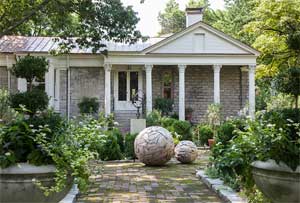Interested in Starting a Local Historic Preservation Board?
Here’s How You Start
By Orloff Miller, Ph.D., Certified Local Government & Planning Coordinator - Kentucky Heritage Council and Terri Johnson, KLC Member Relations Manager
Is your city interested in establishing a historic preservation district? A good first step is to contact the Kentucky Heritage Council, which can help guide your city (or county) government to form a commission or board to oversee preservation.
There are several key steps to follow for access to state and federal funding, and it all starts by being designated as a Certified Local Government (CLG). The CLG Program is a partnership operating with federal, state, and local staff. For designated programs, there are no costs for the state’s CLG services. Participation in Kentucky’s CLG program can also enhance established local Tourism and Kentucky Main Street Programs.

The National Park Service (NPS) Historic Preservation Fund (HPF) provides funding to every State Historic Preservation Office, known in Kentucky as the Kentucky Heritage Council (KHC), under the Tourism, Arts, and Heritage Cabinet.
The Kentucky Heritage Council also administers state and federal preservation and rehabilitation tax credits, which are intended to serve as financial incentives to encourage private investment in historic buildings. Historic Rehab Tax Credits - Kentucky Heritage Council. These programs are important to understand because they can help support rehab projects that are part of a designated Tax Increment Financing (TIF) area, among other programs.
The Kentucky Heritage Council’s staff administers annual grant funds to local Kentucky communities participating in the CLG Program, but program decisions flow from the bottom up. Local governments annually assess their own needs and propose projects for funding the solutions. The program is scaled for public access to decisions and requires local public input.
The CLG Program is based on fostering a preservation ethic. As a historic preservation program, CLG communities commit to an ongoing program of surveying their cultural resources, which may include archaeology sites, as well as the architecture of historic neighborhoods and downtown buildings, structures (such as old cobblestone alleys), and objects (such as the old town clock).
Those cultural resources that meet established criteria may be nominated for commemoration on the National Register of Historic Places (NRHP). In areas where whole city blocks retain their historic significance and integrity, NRHP Districts may be designated. Having a property listed on the NRHP makes landowners eligible for a variety of state and federal assistance programs, including rehabilitation tax credits. However, listing on the NRHP provides no protections for a historic property, nor does it impose any restrictions on the property. The KHC oversees the National Register of Historic Places in Kentucky and assists with nominations. National Register of Historic Places - Kentucky Heritage Council.
The CLG program requires that CLG communities pass a Preservation Ordinance creating a historic overlay district. The Kentucky League of Cities Municipal Law can help cities with this step. This is local law for a local district is not the same as an NRHP District. Within the historic overlay district, landowners are subject to design review for proposed alterations, demolition, or infill projects. A volunteer Preservation Commission (or board) administers the city’s Design Review Guidelines, a professional document outlining the “dos and don’ts” of the local district.
CLG cities must commit to supporting a staff person to administer the program, although the costs and staff can be shared between nearby CLGs. CLG staffers assist landowners in finding compliant solutions for their proposed property alterations. Some cities assign CLG duties to a planner already on the payroll, often with mixed results. KHC staff suggests a dedicated person when possible. Finally, each CLG community commits to creating a freestanding Preservation Plan, which assists in prioritizing the actions of the ongoing program, particularly when some part of the city’s history or population has been under-represented or is under a short- or long-term threat.
Once a city or county government has hired a CLG staff person and passed a Preservation Ordinance, NPS grant funds are available through a competitive grant application process to hire a preservation consulting firm. The firm can write the Design Review Guidelines and Preservation Plan, conduct surveys, or nominate properties to the National Register. Funding is also potentially available for a broad range of activities in support of the program, including (for example) hosting preservation building trades workshops, cemetery restoration workshops, public education, etc. CLG grants require a 60/40 match, and cities can team with local non-profits to assemble a combination of funds and in-kind services to meet the match. Staff time specifically devoted to a grant project can also count towards a match.
Often the biggest threat to a well-preserved neighborhood is the next economic boom. The combination of a Preservation Plan and Design Review Guidelines, along with good zoning laws, can help redirect development pressures away from historic districts and define the historically appropriate scale, proportions, and details of future infill and redevelopment projects. For example, tax increment financing (TIF) for a large-scale redevelopment can either knock down an unprotected historic neighborhood or work within the design review process to create modern enhancements to a functioning historic district. The CLG Program provides a negotiated, collaborative process for mediating between the twin goals of economic redevelopment and historic preservation, ensuring that everyone wins.
Cities participating in the CLG Program are eligible for other NPS Grant programs, including the African American Civil Rights Grant Program (AACR), The Underrepresented Community Grant Program (UCG), The Paul Bruhn Historic Revitalization Subgrant Program (HRSP), Save America’s Treasures Grants (SAT), History of Equal Rights Grants (HER), and Emergency Supplemental Historic Preservation Fund Grants.
For more information on Kentucky’s Certified Local Government Program, please contact Orloff Miller at the Kentucky Heritage Council, 502-892-3606.


